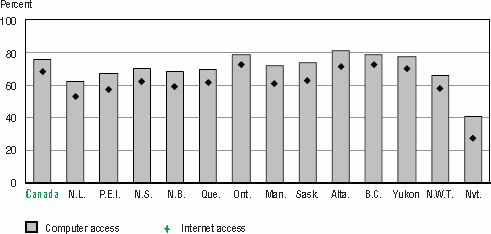
Figure 5.3
Note: Provincial and territorial distributions with standards errors are provided in Annex A Table 5.2.
Source: International Adult Literacy and Skills Survey, 2003.
Figure 5.3 indicates that Ontario, Alberta, British Columbia and the Yukon lead the provinces and territories, with computer access rates close to 80 percent and Internet access rates at or slightly above the national average of 68 percent. The Western provinces have traditionally been leaders in the penetration of high-speed Internet by cable (Veenhof, Neogi and van Tol, 2003). The Atlantic provinces of Newfoundland and Labrador, Prince Edward Island and New Brunswick, along with the Northwest Territories, have Internet penetration rates below 60 percent, while Nunavut trails with just over one-quarter of its population (28 percent) connected to the Internet at home. This partly reflects the fact that many Internet access technologies are not yet available to certain rural or geographically remote communities (Veenhof et al., 2003).
Most computer users also have access to the Internet. Indeed, the survey results show, for most Canadian jurisdictions, that 85 to 90 percent of computer users also have Internet access at home. Nunavut has the lowest access rate among computer users, but still over two-thirds of computer users in that territory have Internet access at home.
Although it is clear that connectivity has increased in Canada, it is instructive to gauge perceptions among non-users. Data from the IALSS reveal that in Canada, 29 percent of individuals aged 16 to 65 who have never used a computer expressed an interest in starting to use one. This presents a challenge if Canada is to succeed in increasing computer connectivity and use among its citizens to near universal levels.
Three composite indices measuring aspects of familiarity with and use of ICTs are developed for analysis in this section. These are the index of respondents’ perceived usefulness and attitude towards computers; the index of diversity and intensity of Internet use; and the index of using computers for task-oriented purposes (See Text Box C5).